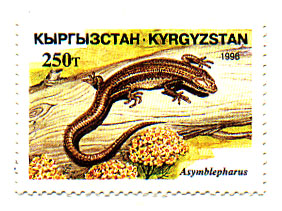
Ablepharus is a genus of skinks that contains the common snake-eyed skinks. Both their scientific and common names refer to the fact that their eyelids have fused to a translucent capsule; as in snakes, they thus are physically incapable of blinking. They are small lizards and prefer to live in the leaf litter of dry fields and hills. Their scales give them a very shiny, bronze appearance with a characteristically dark stripe down the sides of their bodies. They prey on small insects and other small mollusks.
The minor snake-eyed skink is a species of lizard in the family Scincidae. The species is native to Asia.

Eumeces schneiderii, commonly known as Schneider's skink, is a species of lizard in the family Scincidae. The species is endemic to Central Asia, Western Asia, and North Africa. There are five recognized subspecies.

Riopa guentheri, commonly known as Günther's supple skink and Günther's writhing skink, is a species of lizard in the family Scincidae. The species is endemic to India.
Ablepharus ladacensis, also known as the Ladak ground skink, is a species of skink found in Tibet (China), North India, western Nepal, and northern Pakistan.

Ablepharus kitaibelii, also known commonly as the European copper skink, the European snake-eyed skink, the juniper skink, and the snake-eyed skink, is a species of skink, a lizard in the subfamily Eugongylinae of the family Scincidae. The species is native to Eastern Europe and Southwestern Asia.
Ablepharus sikimmensis is a species of skink found in Bangladesh (Rangpur), Bhutan, China (Tibet), India and Nepal.

Ablepharus budaki, commonly known as Budak's skink and Budak's snake-eyed skink, is a species of lizard in the family Scincidae. The species is endemic to the Near East.

Ablepharus rueppellii, known commonly as Rüppell's snake-eyed skink, is a species of skink found in the Middle East. It was formerly considered a subspecies of Ablepharus kitaibelii, but has since been distinguished. What is currently recognized as this species is possibly two distinct species.

Wright's skink, also known commonly as Wright's mabuya, is a species of lizard in the family Scincidae. The species is endemic to Seychelles. There are two recognized subspecies.
Ablepharus darvazi, also known as Darvaz snake-eyed skink, is a species of skink, a lizard in the family Scincidae. The species is endemic to Central Asia.

Darevskia raddei, known commonly as the Azerbaijan lizard, is a species of lizard in the family Lacertidae. The species is endemic to Eurasia. There are three subspecies.

Darevskia valentini, also known commonly as the Caucasian rock lizard or Valentin's lizard, is a species of lizard in the family Lacertidae. The species is native to southeastern Europe and western Asia. There are three recognized subspecies.
The red-tailed soil-crevice skink, also known commonly as Kinghorn's grassland striped skink and Kinghorn's snake-eyed skink, is a species of skink, a lizard in the subfamily Eugongylinae of the family Scincidae. The species is endemic to Australia.
Proablepharus tenuis, also known commonly as Broom's small skink and the northern soil-crevice skink, is a species of skink, a lizard in the family Scincidae. The species is endemic to Australia.
Mochlus hinkeli, also known commonly as Hinkel's red-flanked skink and Hinkel's red-sided skink, is a species of lizard in the family Scincidae. The species is native to eastern Central Africa and East Africa. There are two recognized subspecies.
Eutropis darevskii, also known commonly as Darevsy's mabouya, Darevsky's mabuya, and Darevsky's skink, is a species of lizard in the family Scincidae. The species is endemic to Vietnam.

Ablepharus eremchenkoi is a species of skink, a lizard in the family Scincidae. The species is native to Kazakhstan and Kyrgyzstan.
Chernov's snake skink is a species of skink, a lizard in the family Scincidae. The species is native to Western Asia and Central Asia.











